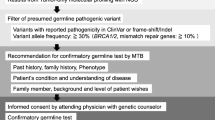Abstract
In June 2019, the Japanese National Health Insurance (NHI) system introduced coverage for two types of tumor genomic profiling (TGP): FoundationOneⓇ CDx (F1) and OncoGuide™ NCC OncoPanel System (NCCOP). TGP sometimes reveals germline variants that are potentially pathogenic as secondary findings (SFs). We conducted a questionnaire-based survey to find out the operational statuses of F1 and NCCOP at institutions where TGP was performed to elucidate issues related to SFs. Responses were received from 97 of 112 institutions (86.6%). As of May 31, 2020, 88 (90.7%) and 78 (80.4%) institutions started performing F1 and NCCOP, respectively. Since F1 only examines tumor samples, germline confirmatory testing is necessary to determine whether they are actually germline pathogenic variants (GPVs). When physicians are obtaining informed consent all but 2.3% of the patients requested SF disclosure. Conversely, when presumed germline pathogenic variants (PGPVs) were detected, 46.2% were not willing to receive confirmatory tests as they wanted to prioritize cancer treatment over SFs investigation, while only 23.3% underwent confirmatory tests. Problems in cancer genomic medicine reported by clinical genetics departments included short-staffing (n = 10), insufficient interdepartmental cooperation (n = 9), inconsistent understanding of genetics among healthcare professionals (n = 8), and low utilization rate of SFs due to lack of insurance coverage for confirmatory tests and post-test health checkups (n = 8). Solutions include; determining the appropriate timing to confirm patient intent on SF disclosure, covering confirmatory tests for PGPVs by the NHI, and establishing cooperation between the oncology and clinical genetics departments.
This is a preview of subscription content, access via your institution
Access options
Subscribe to this journal
Receive 12 print issues and online access
$259.00 per year
only $21.58 per issue
Buy this article
- Purchase on Springer Link
- Instant access to full article PDF
Prices may be subject to local taxes which are calculated during checkout




Similar content being viewed by others
References
Japanese Society of Medical Oncology, Japanese Society of Clinical Oncology, Japanese Cancer Association. Clinical practice guidance for next-generation sequencing in cancer diagnosis and treatment, edition 2.1. 2020. https://www.jsmo.or.jp/about/doc/20200310.pdf.
MHLW. Progress of efforts to promote cancer genomic medicine. 2019. https://www.mhlw.go.jp/content/10901000/000573711.pdf.
Mukai Y, Ueno H. Establishment and implementation of Cancer Genomic Medicine in Japan. Cancer Sci. 2021;112:970–7.
Japan Agency for Medical Research and Development. Proposal concerning the information transmission process in genomic medicine Part 1: Focusing on comprehensive tumor genomic profiling analysis, revised 2nd ed. 2019. https://www.amed.go.jp/content/000064662.pdf.
MHLW. Report of the fact-finding survey of gene panel tests. 2019. https://www.mhlw.go.jp/content/10901000/000573712.pdf.
MHLW. Report from liaison conference of designated core hospitals for cancer genomic medicine, etc. 2019. https://www.mhlw.go.jp/content/10901000/000573713.pdf.
Stjepanovic N, Stockley TL, Bedard PL, McCuaig JM, Aronson M, Holter S, et al. Additional germline findings from a tumor profiling program. BMC Med Genomics. 2018;11:65.
Meric-Bernstam F, Brusco L, Daniels M, Wathoo C, Bailey AM, Strong L, et al. Incidental germline variants in 1000 advanced cancers on a prospective somatic genomic profiling protocol. Ann Oncol. 2016;27:795–800.
Sunami K, Ichikawa H, Kudo T, Kato M, Fujiwara Y, Shimomura A, et al. Feasibility and utility of a panel testing for 114 cancer-associated genes in a clinical setting: a hospital-based study. Cancer Sci. 2019;110:1480–90.
Lebedeva A, Shaykhutdinova Y, Seriak D, Ignatova E, Rozhavskaya E, Vardhan D, et al. Incidental germline findings during molecular profiling of tumor tissues for precision oncology: molecular survey and methodological obstacles. J Transl Med. 2022;20:29.
Shimada S, Yamada T, Iwakuma M, Kosugi S Physicians’ perceptions of the factors influencing disclosure of secondary findings in tumour genomic profiling in Japan: a qualitative study. Eur J Hum Genet. 2021. https://doi.org/10.1038/s41431-021-00944-4.
Acknowledgements
We would like to thank all personnel at the institutions that returned questionnaires. This study was supported by the Japan Ministry of Health, Labour and Welfare (grant numbers: 20AD1001).
Author information
Authors and Affiliations
Corresponding author
Ethics declarations
Competing interests
The authors declare no competing interests.
Additional information
Publisher’s note Springer Nature remains neutral with regard to jurisdictional claims in published maps and institutional affiliations.
Rights and permissions
About this article
Cite this article
Minamoto, A., Yamada, T., Shimada, S. et al. Current status and issues related to secondary findings in the first public insurance covered tumor genomic profiling in Japan: multi-site questionnaire survey. J Hum Genet 67, 557–563 (2022). https://doi.org/10.1038/s10038-022-01028-x
Received:
Accepted:
Published:
Issue Date:
DOI: https://doi.org/10.1038/s10038-022-01028-x
This article is cited by
-
Genetic medicine in companion diagnostics of germline BRCA testing of Japanese pancreatic cancer patients
Journal of Human Genetics (2023)
-
Expectations, concerns, and attitudes regarding whole-genome sequencing studies: a survey of cancer patients, families, and the public in Japan
Journal of Human Genetics (2023)
-
Management of patients with presumed germline pathogenic variant from tumor-only genomic sequencing: A retrospective analysis at a single facility
Journal of Human Genetics (2023)



